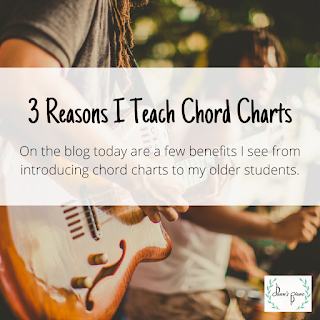Three Reasons I Teach Chord Charts
One thing a lot of people imagine being able to do when they take piano lessons, or sign their child up for piano lessons, is to just sit down and play at family gatherings or parties. Perhaps we even think of eventually being able to take requests of everything from classical or contemporary solo selections, to popular music that other musicians could jam along with or the crowd could sing along to. And this can sometimes be a tricky area of expectation vs reality because classical playing and 'jamming' can feel like two separate musicianship skills until we mature as musicians enough to see the overlap.
Chord charts and lead sheets are tools that a lot of modern bands, worship teams, etc, use to pick up a song together quickly. They serve as a guide without prescribing every single note. I've talked on the blog in the past about lead sheets. So in today's blog post, I'm sharing 3 reasons why I choose to introduce chord charts to my older students' piano study.
First, let's define what I mean when I say a chord chart. These terms are not 100% standardized by geographic area and musical genre. So when I say chord chart, I'm referring to a page that just has lyrics and chords only. There isn't any on-staff notation. It might look something like this:
So now that we know what we're talking about, here are my 3 reasons for being sure to include chord charts in my older students' lessons.
Music Theory
To play even the most basic chord chart, you have to know how to build a number of different chords. They provide excellent practice in chord structure and progressions, the chance to use inversions for different voicings, and they build our familiarity with lots of different types of chords (major, minor, 7th, diminished, augmented, & suspended chords are all common, and then there are plenty of other variations that pop up too). Part of the reason I wait to formally introduce these until around Middle School is because I prefer students to be able to have a foundation of some basic chords & scales from their elementary study, so they are ready to grow into understanding how that all works in relationship together. The world of chords and tonalities is actually based on a few simple rules, but it can feel quite big and overwhelming if we don't have the foundation to see the larger pattern yet.
(This is just a teaching preference in my case, and is by no means the right or only way/level to introduce chord charts. In my work with middle school students at Arts After School, we actually use chord charts almost exclusively from the beginning levels for these older beginners. So my keyboard students there instead get a quick 'crash course' in chord building with the understanding that we'll hopefully see the larger patterns emerge as we progress).
Creative License
When playing a chord chart, the only prescribed thing are the chords, and the time signature of the song. Within those structures we get to create our own version of the piece. And our version can be as simple or as complicated as we want to make it. Since I choose to introduce this to students who have a little music experience already, it means their fingers do know already know a number of different musical styles that we can fall back on as different songs call for. I personally enjoying seeing how each student finds their own 'voice' with improvisational styles.
More Opportunities for Collaborative Music
An understanding of chord charts opens the doors into playing in a lot more modern band settings. Nearly every band or worship team that I've played with has handed me chord charts. It also makes taking requests at a singalong easier if you are not comfortable playing by ear (though my personal favorite for piano solo requests is a fake book of lead sheets). My thoughts are that if piano students are able to interpret both traditional sheet music, as well as lead sheets and chord charts, they'll have that many more avenues for making music and collaborating with other musicians throughout their life. And since the goal of teaching music is to equip students with the tools to be well-rounded, and lifelong, this is definitely a skill worth including.
I treat chord charts the same way I do composing, improvisation and other creative forms of playing. I introduce students to the concept, give them the basic tools, and then let their interest guide how far we go with it. Not every piano student has aspiration to be a composer, classical pianist, or a pop-rock keyboard player, etc. But someday their interest may take them to one of those places, so it doesn't hurt to have the skills, just in case.

